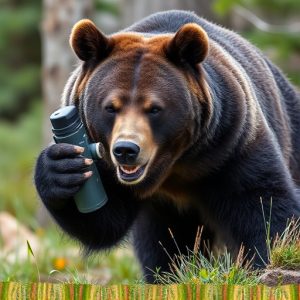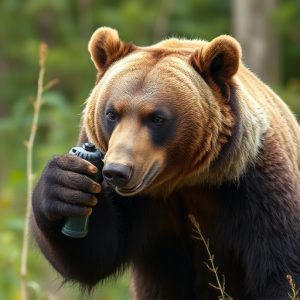Unveiling Maximum Strength Capsaicin in Bear Spray: Concentrations & Effectiveness
The effectiveness of bear spray, a crucial tool for safety in bear country, depends on its capsaicin…….
The effectiveness of bear spray, a crucial tool for safety in bear country, depends on its capsaicin concentration. Maximum strength formulas (20% or higher) temporarily disable bears by disrupting sensory receptors, providing vital escape time. Outdoor enthusiasts should understand capsaicin levels to ensure the right bear spray meets their needs regarding range and potency. Higher capsaicin concentrations offer longer-lasting protection by masking human odors and reducing bear attraction. Proper handling, storage, and application techniques, along with adherence to local regulations, are essential for optimal safety and efficacy in bear country.
“Uncovering the Power of Bear Spray: A Comprehensive Guide to Maximum Strength Capsaicin. Bears pose a significant threat in many outdoor environments, making bear spray a crucial tool for safety. This article delves into the world of bear repellent, focusing on the active ingredient capsicin concentration. We explore how maximum strength capsaicin works, its effectiveness compared to other repellents, and regulatory aspects that ensure user safety. Understanding these factors is key to navigating potential bear encounters.”
- Understanding Bear Spray and Its Active Ingredients
- The Role of Capsaicin in Bear Repellents
- Deciphering Concentrations: What is Maximum Strength?
- Safety, Effectiveness, and Regulatory Considerations
Understanding Bear Spray and Its Active Ingredients
Bear spray, a powerful deterrent designed to protect individuals from aggressive bears, has become an indispensable tool for outdoor enthusiasts and those living in bear country. At its core, bear spray relies on a specific active ingredient: capsaicin, the same compound that gives chili peppers their heat. The capsaicin concentration in bear repellent plays a crucial role in its effectiveness.
Maximum strength bear spray typically contains 20% capsaicin or higher. This high concentration disrupts the sensory receptors in a bear’s nose and mouth, temporarily incapacitating them and providing the user with precious time to retreat or defend themselves. Understanding the capsaicin concentration is essential when choosing the right bear spray for your needs, as it directly impacts both its range and potency.
The Role of Capsaicin in Bear Repellents
The active ingredient in many bear spray repellents is capsaicin, a compound found in chili peppers that gives them their heat and pungent flavor. Bear repellent manufacturers carefully formulate products to contain specific concentrations of capsaicin, aiming for maximum effectiveness in deterring bears. The capsaicin concentration in bear repellent directly correlates with its potency; higher concentrations typically provide longer-lasting protection against aggressive bear encounters.
In addition to its role as a natural pain reliever and anti-inflammatory agent, capsaicin serves as an effective scent masker, obscuring human odors from bears. This is crucial for hikers, campers, and others venturing into bear country, as it reduces the likelihood of attracting hungry or curious bears. Understanding the capsaicin concentration in bear repellent allows users to make informed decisions about their safety while outdoors in potentially hazardous environments inhabited by these powerful wild animals.
Deciphering Concentrations: What is Maximum Strength?
When it comes to bear spray, understanding the capsaicin concentration is key. Maximum strength refers to the highest level of capsaicin, the active ingredient responsible for the spray’s effectiveness. This potent compound is derived from chili peppers and has a direct impact on an animal’s pain receptors, deterring them from approaching.
The strength of bear repellent can be measured in parts per million (ppm). A maximum strength product typically contains 10% or more capsaicin, ensuring a powerful and long-lasting effect. This high concentration provides added protection for individuals venturing into areas known to have bear populations, offering a robust defense against potential attacks.
Safety, Effectiveness, and Regulatory Considerations
When it comes to bear spray, safety is paramount. It’s designed for emergency situations and should only be used as a last resort when facing an aggressive bear encounter. Understanding how to properly handle, store, and apply the spray is crucial for minimizing risks. The effectiveness of bear spray relies heavily on the capsaicin concentration, with higher strengths offering better protection against potential attacks. Studies have shown that a high-quality, maximum strength capsaicin spray (typically around 2 million Scoville Heat Units/gram) can deter bears effectively when used correctly.
Regulatory considerations play a significant role in the production and sale of bear sprays. Different regions have varying standards and requirements for these products. Manufacturers must adhere to strict guidelines regarding capsaicin concentration, ingredient listings, and labeling to ensure consumer safety and product efficacy. Always check local regulations before purchasing bear spray and follow instructions meticulously when using it in the field.
The optimal defense against bear encounters lies in understanding the science behind bear spray and its active ingredients, particularly capsaicin concentration. As a key component in bear repellents, capsaicin’s ability to disrupt an animal’s sensory system makes it an effective tool for personal safety in bear country. When choosing a bear spray, seeking products with higher capsaicin concentrations ensures maximum strength and protection against aggressive bears. However, it’s crucial to balance effectiveness with safety, adhering to regulatory guidelines to ensure responsible usage of these potent substances.


